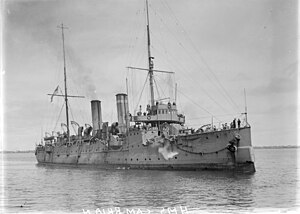
HMS Australia was one of seven Orlando-class armoured cruisers built for the Royal Navy in the mid-1880s. She was assigned to the Mediterranean Fleet in 1889 and remained there until 1893 when she returned home. The ship was assigned to the Coast Guard Squadron for the next decade before she was placed in reserve in 1903. Australia was sold for scrap in 1905.
Admiral Sir Ernest Frederick Augustus Gaunt, was an Australian-born Royal Navy officer who went on to be Commander-in-Chief, Western Approaches.

HMS Mildura was a Pearl-class cruiser built for the Royal Navy in the late 1880s. Originally named HMS Pelorus, she was renamed after an Australian town in April 1890. Per the Imperial Defense Act of 1887, she served primarily in Australian waters.
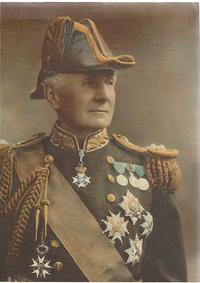
Admiral Sir Francis Charles Bridgeman Bridgeman was a Royal Navy officer. As a captain he commanded a battleship and then an armoured cruiser and then, after serving as second-in-command of three different fleets, he twice undertook tours as Commander-in-Chief of the Home Fleet with a stint as Second Sea Lord in between those tours. He became First Sea Lord in November 1911 but clashed with First Lord of the Admiralty Winston Churchill on technical issues as well as matters relating to a perceived overriding of naval traditions by Churchill: this led to Bridgeman's resignation just a year later.

HMS Royal Arthur was a first class cruiser of the Edgar class, previously named Centaur, but renamed in 1890 prior to launching. She served on the Australia Station and briefly on the North America and West Indies Station before returning to the Home Fleet in 1906. She was paid off after the First World War.
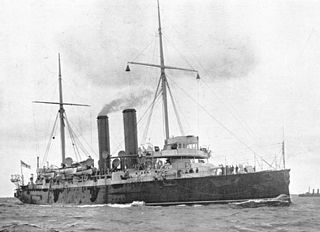
HMS St George was a first class cruiser of the Edgar class. She was launched on 23 June 1892.

HMS Drake was the lead ship of her class of armoured cruisers built for the Royal Navy around 1900. She was assigned to several different cruiser squadrons in home waters upon completion, sometimes as flagship, until 1911 when she became the flagship of the Australia Station. Upon her return home, she was assigned to the 6th Cruiser Squadron of the 2nd Fleet and became the squadron's flagship when the fleet was incorporated into the Grand Fleet upon the outbreak of the First World War.

HMS Orlando was the lead ship of the Orlando class of first-class cruisers built in the yards of Palmers Shipbuilding and Iron Company, Jarrow and launched on 3 August 1886.

Admiral Sir Assheton Gore Curzon-Howe, was a British naval officer who served as Commander-in-Chief, Mediterranean Fleet from 1908 to 1910.

HMS Royal Sovereign was the lead ship of the seven ships in her class of pre-dreadnought battleships built for the Royal Navy in the 1890s. The ship was commissioned in 1892 and served as the flagship of the Channel Fleet for the next five years. She was transferred to the Mediterranean Fleet in 1897 and returned home in 1902, and was briefly assigned as a coast guard ship before she began a lengthy refit in 1903–1904. Royal Sovereign was reduced to reserve in 1905 and was taken out of service in 1909. The ship was sold for scrap four years later and subsequently broken up in Italy.
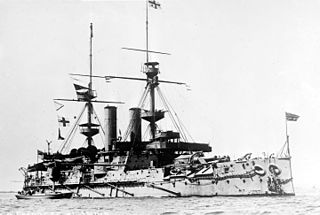
HMS Empress of India was one of seven Royal Sovereign-class pre-dreadnought battleships built for the Royal Navy during the 1890s. The ship was commissioned in 1893 and served as the flagship of the second-in-command of the Channel Fleet for two years. She was transferred to the Mediterranean Fleet in 1897, during which time Empress of India was assigned to the International Squadron blockading Crete during the uprising there. She returned home in 1901 and was briefly assigned as a coast guard ship in Ireland before she became the second flagship of the Home Fleet. The ship was reduced to reserve in 1905 and accidentally collided with the submarine HMS A10 the following year. Empress of India was taken out of service in early 1912 and accidentally struck a German sailing ship while under tow. She was sunk as a target ship in 1913.

HMS Flora was an Astraea-class cruiser of the Royal Navy launched on 21 November 1893. She was constructed under the Naval Defence Act 1889 along with several other Astraea-class cruisers. Flora was decommissioned in 1922.

Admiral of the Fleet Sir Osmond de Beauvoir Brock, was a Royal Navy officer. Brock served as assistant director of naval intelligence and then as assistant director of naval mobilisation at the Admiralty in the early years of the 20th century. During the First World War Brock commanded the battlecruiser HMS Princess Royal at the Battle of Heligoland Bight and at the Battle of Dogger Bank. He then commanded the 1st Battlecruiser Squadron with his flag in HMS Princess Royal at the Battle of Jutland.
Admiral Sir George Lambart Atkinson-Willes was a Royal Navy officer who went on to be Commander-in-Chief, East Indies Station.

HMS Mohawk was an Archer-class torpedo cruiser of the Royal Navy, built by J. & G. Thompson at Glasgow and launched on 6 February 1886.
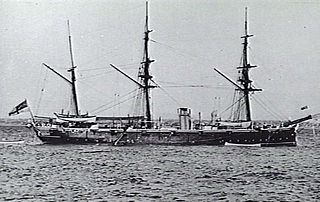
HMS Pylades was a Satellite-class composite screw sloop of the Royal Navy, built at Sheerness Dockyard and launched on 5 November 1884. She was later reclassified as a corvette and was the last corvette built for the Royal Navy until the Second World War.

HMS Lizard was a Bramble-class screw gunboat of the Royal Navy, built by Harland & Wolff, Belfast and launched on 27 November 1886.

HMS Diana was an Eclipse-class protected cruiser built for the Royal Navy in the mid-1890s.
Admiral Sir Arthur Murray Farquhar, was a British Royal Navy officer in the years before the First World War.
Admiral Frank Finnis was a British Royal Navy admiral before the First World War.
